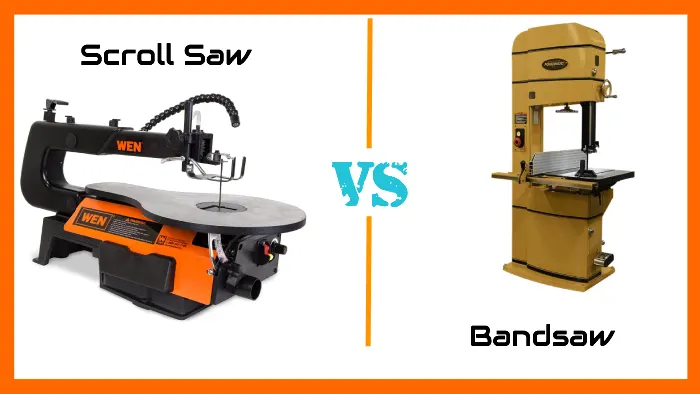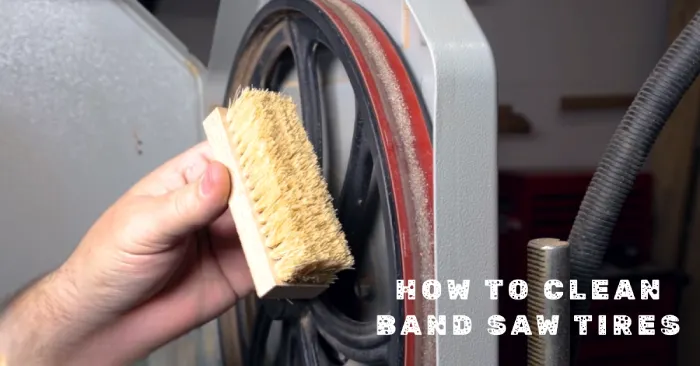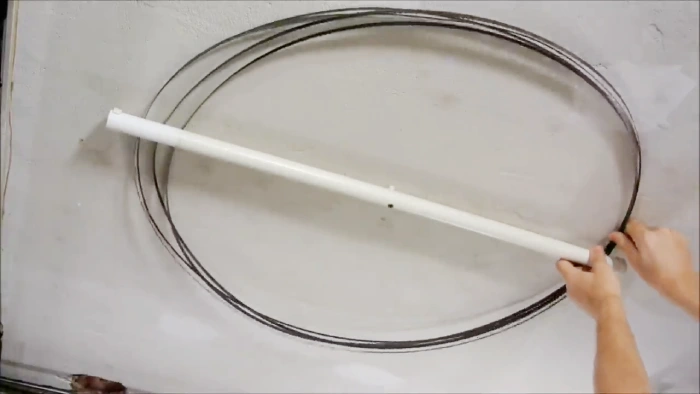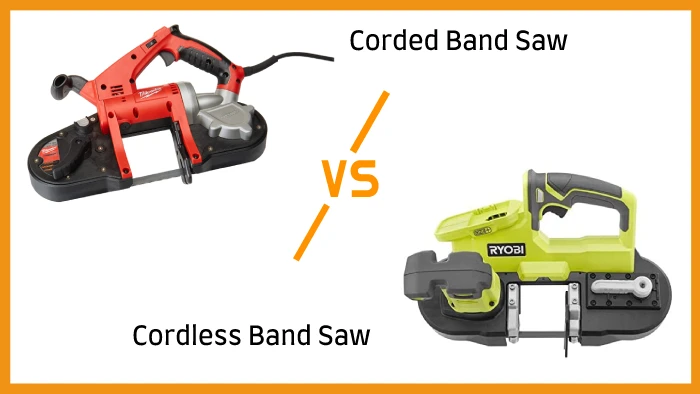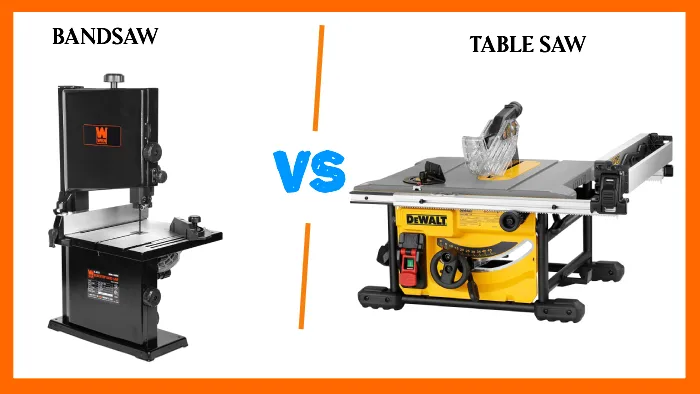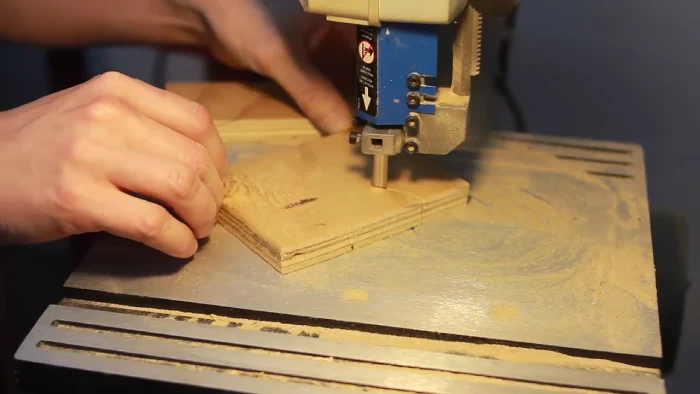Difference Between Scroll Saw and Bandsaw: 8 Key Distinctions
Scroll saw and bandsaw are two popular woodworking tools that serve different purposes and have distinct features. Understanding these differences helps you decide which tool is best suited for a specific project.
Based on my observations, one difference lies in their blade type and motion. A scroll saw utilizes a thin, small blade that moves up and down, making it perfect for intricate work.
On the other hand, a bandsaw features a continuous looped blade that moves downward, offering versatility for larger tasks.
Another distinction is the blade length, with scroll saws using shorter blades for delicate work, while bandsaws offer a range of lengths to cater to different cutting needs.
I will discuss all the differences between the scroll saw and bandsaw so that you can choose the most suitable tool for your woodworking project.
- Quick blade change with side panel
- Adjustable speed from 550-1600 SPM
- Cuts 2-inch thick wood easily
- Built-in air pump clears debris
- Cast iron base reduces vibrations
- Powerful 2.8-amp motor, 2500 RPM
- Cuts up to 3-1/2″ deep, 9″ wide
- Accommodates 1/8″ to 3/8″ blades
- Spacious 12-1/4″ x 11-7/8″ work table
- Bevels up to 45 degrees
8 Differences Between Scroll Saw and Bandsaw

Bandsaws and scroll saws are two entirely different tools, and they differ in the following key areas:
- Blade type and motion
- Blade length
- Cutting capacity and radius
- Cutting speed
- Ideal applications
- Size and portability
- Noise level
- Cost
1. Blade Type and Motion
One difference between a scroll saw and a bandsaw is the blade type and motion. A scroll saw is equipped with a thin, small blade that moves up and down in a reciprocating motion.
This design allows for precise and intricate cuts, making it perfect for tasks like puzzles, ornaments, fretwork, or inlays.
In contrast, a bandsaw features a long, continuous looped blade that moves downward. This design offers versatility for various woodworking projects, especially those involving larger and thicker materials or long straight cuts.
2. Blade Length
There is also a difference in the blade length between a scroll saw and a bandsaw. Scroll saw blades are typically around 5-1/4 to 6 inches in length, perfect for intricate and delicate work.
On the other hand, bandsaw blades come in a wide range of lengths, ranging from 59 ½ inches to 145 inches. This versatility allows you to choose a blade length that suits the specific cutting needs of your projects.
Whether you need a compact 59 ½-inch blade for detailed work or a longer 145-inch blade for larger tasks, plenty of options are available. Intermediate lengths such as 70 ½ inches, 72 ½ inches, 99 ¾ inches, 101 ½ inches, 111 inches, and 125 inches provide even more flexibility.
3. Cutting Capacity and Radius
Scroll saws are limited in cutting capacity and are suitable for thinner materials up to 2 inches thick. Conversely, bandsaws have a greater cutting capacity, capable of handling thicker materials that often exceed 2 inches. This is due to their larger blades and continuous motion.
Additionally, bandsaws offer a larger cutting radius compared to scroll saws, making them more versatile for various woodworking tasks.
4. Cutting Speed
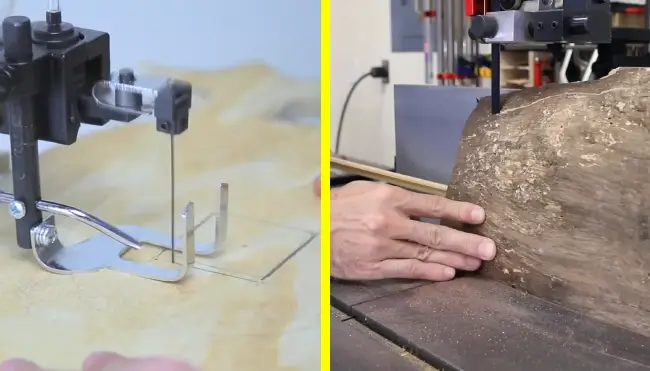
Regarding cutting speed, scroll saws typically operate slower, especially when intricate detailing is required. This slower speed allows for more precise cuts in delicate designs.
On the other hand, bandsaws operate at a faster speed, making them more efficient for tasks involving larger materials. The speed difference is due to the unique blade designs and the nature of the cuts each saw is designed for.
5. Ideal Applications
In woodworking, scroll saws and bandsaws have distinct applications suited to a variety of materials and projects.
Scroll saws excel in intricate and detailed work, making them perfect for crafting projects like puzzles, ornaments, fretwork, and inlays. Their ability to perform pierced cuts adds to their suitability for artistic designs.
Meanwhile, bandsaws are more versatile and can handle a wider range of tasks. They’re ideal for ripping lumber, making veneer, crosscutting, and cutting curves in larger and thicker materials. Bandsaws shine in tasks related to furniture making and larger woodworking projects.
Whether you need precise and delicate cuts or versatile cutting capabilities, choosing between a scroll saw and a bandsaw depends on the specific requirements of your project.
6. Size and Portability
The size and portability of scroll saws and bandsaws differ due to their physical characteristics.
Scroll saws are typically smaller and more compact, often designed to be tabletop or bench-mounted. This makes them easier to store and maneuver in smaller workspaces.
On the other hand, bandsaws have larger frames and floor-standing designs, making them bulkier and less portable. However, it’s worth noting that portable bandsaws are available for those who need more mobility in their woodworking projects.
7. Noise Level
Noise levels vary between scroll saws and bandsaws. Scroll saws, operating at slower speeds and with smaller blades, tend to produce less noise than bandsaws. This is because the smaller blades of a scroll saw create less vibration and friction, resulting in a quieter operation.
In contrast, bandsaws, especially larger models with more powerful motors, can generate more noise during operation. The powerful motor and larger blade size contribute to the increased noise output.
8. Cost
Another notable distinction is the cost when considering the differences between a scroll saw and a bandsaw. Scroll saws are generally more affordable, with prices ranging from $100 to $1,000. This makes them accessible to a wide range of budgets.
On the other hand, bandsaws have a wider price range, starting from around $200 for budget benchtop models and going up to $3,000 or more for large floor-standing models.
Corded and cordless handheld bandsaws for job sites fall in the range of $200 to $600. The cost difference reflects the machinery’s complexity and the tool’s intended use. However, you need to note that these prices may vary over time for both saws.
Comparison Chart Between Scroll Saw and Bandsaw
| Aspects | Scroll Saw | Bandsaw |
| Blade Type and Motion | Thin, small blade, up and down motion (reciprocating). | Continuous looped blade, downward motion. |
| Blade Length | Typically 5-1/4 to 6 inches. | Ranges from 59 ½ inches to 145 inches, various options. |
| Cutting Capacity | Limited, suitable for thinner materials up to 2 inches. | Greater capacity, handles thicker materials (>2 inches). |
| Cutting Radius | Limited radius. | Larger cutting radius, more versatile for curves. |
| Cutting Speed | Slower speed for intricate detailing. | Faster speed, efficient for larger materials. |
| Ideal Applications | Intricate and detailed work (puzzles, ornaments). | Versatile tasks: ripping lumber, veneer, curves, etc. |
| Size and Portability | Smaller and more compact, often tabletop or bench-mounted. | Larger frames, floor-standing (some portable options). |
| Noise Level | Lower noise due to slower speed and smaller blades. | Higher noise, especially in larger models. |
Can you use a scroll saw for straight cuts in larger materials?
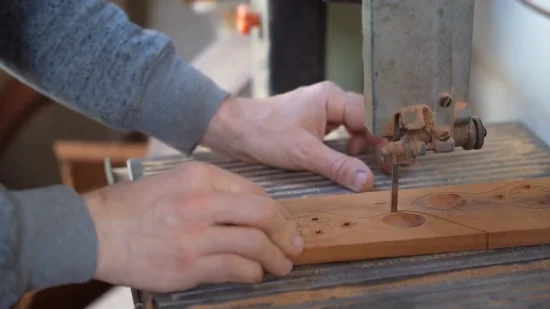
Using a scroll saw for straight cuts in larger materials may not be the most efficient choice. The thin blade’s up-and-down motion can pose challenges in maintaining a straight line over extended distances.
While the scroll saw excels in intricate, curved designs and detailed work, its design and blade motion make it less suitable for long, straight cuts in larger materials.
A bandsaw is generally the more appropriate tool for woodworking projects involving substantial straight cuts in larger materials. Designed for versatility, bandsaws can efficiently handle straight cuts, making them the preferred choice for tasks that demand precision in larger pieces of wood or other materials.
How long do scroll saw blades typically last before needing replacement?
The lifespan of scroll saw blades typically ranges from 15 to 20 hours of cutting time before replacement is needed due to dullness. This estimate considers the wear and tear that occurs as the blade contacts various materials during use.
If you use your scroll saw regularly or engage in projects that exert more pressure on the blade, you might find it necessary to replace the blades more frequently to maintain optimal cutting performance.
To extend the life of your scroll saw blades and prevent premature breakage, it’s essential to use the appropriate blade type for the material, ensure proper tensioning, and employ steady and controlled cutting techniques.
Regular inspection for signs of wear and maintaining good blade care practices can also contribute to keeping scroll saw blades from breaking.
Do bandsaws require more maintenance than scroll saws?
Maintaining a bandsaw generally involves a bit more effort compared to a scroll saw. Bandsaws, with their larger and more complex design, require regular maintenance to ensure optimal performance.
This maintenance routine often includes tasks such as blade tension adjustments, checking and aligning the blade guides, and occasionally replacing the bandsaw blade. Also, bandsaws may need periodic checks on the overall alignment and condition of the wheels and bearings.
While the maintenance requirements for bandsaws are more involved, they contribute to the longevity and efficiency of the tool, especially when used for larger and more demanding woodworking tasks.
On the other hand, scroll saws, being smaller and simpler in design, typically require less frequent and less intricate maintenance. Regular cleaning, occasional blade replacements, and ensuring proper tension are usually sufficient to keep a scroll saw in good working condition.
Can you cut metal with a bandsaw?
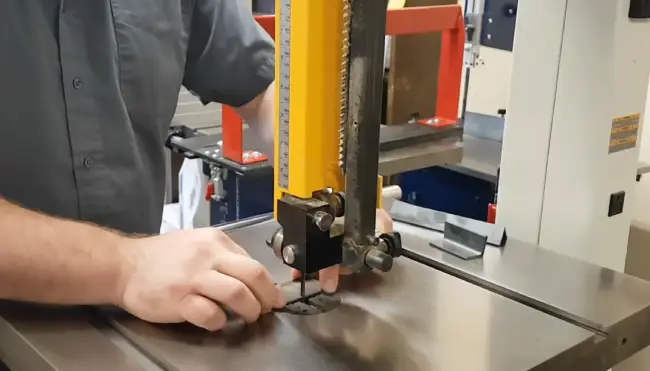
You can cut metal with a bandsaw. Bandsaws are versatile tools capable of handling a variety of materials, including metal. To cut metal effectively with a bandsaw, it’s essential to use the appropriate blade designed for metal cutting.
These blades are specially designed to withstand the demands of cutting through metal and ensure cleaner and more precise results.
When using a bandsaw for metal cutting, adjusting the blade speed and making proper blade tension adjustments are crucial to optimize performance. Remember that while bandsaws can cut metal, dedicated metal-cutting saws may provide even better results for certain applications.
Choose Between the Scroll Saw or Bandsaw for Your Woodworking Needs
Based on my shared insights into the distinctions between a scroll saw and a bandsaw, I hope you now understand what each tool is good for. From blade types and lengths to cutting capacities and applications, the differences provide valuable guidance for choosing the right tool for your specific project needs.
Whether you prioritize intricate detailing or versatile cutting capabilities, your decision should align with the demands of your woodworking endeavors. Select the woodworking tools that best complement your project requirements, ensuring precision and efficiency in your craftsmanship.
- Dust Port Adapter for Clear Workspace
- Quick-Change Mechanism for Easy Accessories
- Detachable Coping Function for Portability
- Variable-Speed Control for Versatile Cutting
- Fast-Clamp Base for Secure Attachment
No products found.
Last update on 2025-11-23 / Affiliate links / Images from Amazon Product Advertising API

